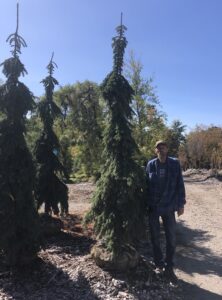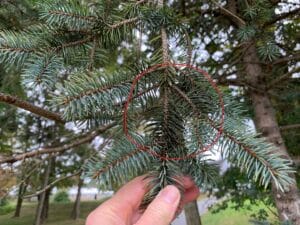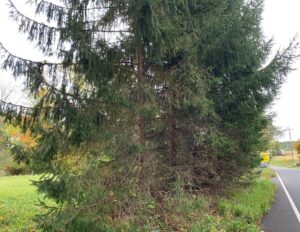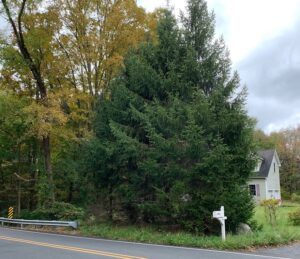Hello fellow readers, While spruce disease dilemmas such as Canker Disease and Needle Cast are sadly destroying trees, there are lessons to gain from prevention and remedies that came from an exchange with new clients I’d like to share.
It is a delight to begin working with Lori and Greg of Long Valley, NJ, who moved from Staten Island into a farmhouse to live a dream. Including rescuing miniature horses, goats, and other critters such as exotic birds and chickens, now pets.
Lori describes her taste as a “structured wild child,” and a “fairytale-ish” garden is her wish. They arrived in their new home six months ago, and already Greg is transforming the badly pruned row of boxwood into a charming squarish shape. Surrounding the hedge is a wildly colorful random assortment of plants recently planted.
A priority is to replace a crabapple formerly on the left side of the historic stone farmhouse. Greg and Lori desire an evergreen that will mature to twenty feet tall by six feet wide.
Weeping White Spruce – How the Grinch Stole Christmas
Ben Jansen of E.P. Jansen Nursery in Florida, NY, my favored nurseryman, suggested weeping white spruce, which is a great idea. Picea glauca ‘Pendula’ is tall and skinny, reaching up to twenty to thirty feet tall and six to ten feet wide. It’s graceful yet rustic, reminding me of the Christmas tree in Dr. Seuss’s How the Grinch Stole Christmas. Recall how the Whos in Whoville circle the tree with hands in each other’s hands—singing with love and celebration on Christmas morning despite being stripped of decorations by the Grinch.
Greg heard some spruces are plagued with a fungus called Needle Cast. “A colleague is removing fifteen from her property due to damage.” He said, “she heard of a resistant fir tree.”
About Cytospora Canker (aka Spruce Canker Disease)
It’s true spruces, primary blue spruces in this neck of the woods, have been on the decline primarily because of Cytospora Canker (aka Canker Disease). And, as Greg learned, Rhizospharea Needle Cast is another fungal dilemma affecting them. The symptoms are similar.
Canker Disease usually shows up as random branch dieback, generally starting with the lower branches. First, needles brown on the dead branch before they fall off. Upon close inspection, you’ll notice an oozing white sap, the tree’s response to the fungus. If infected, pruning the dead branches during dry conditions prohibiting the spread of the fungus is the best remedy. They say fungicide sprays are not usually effective.
Then there’s Needle Cast Spruce Disease.
On the other hand, Needle Cast can be identified by the tiny black dots on infected needles and the fruiting structures of the fungus. It also typically starts on the lower branches, but not always. Year-two, the needles turn brown or purplish before falling from the tree. If early symptoms appear, spray a fungicide suitable to treat Needle Cast in the last two weeks of May. Then again, four to six weeks later.
Like Ben, I have never heard of fir trees resistant to Needle Cast. Firs are, in fact, the most vulnerable. “The only firs I carry are white fir because they seem to be the most resistant now. I don’t carry Douglas Fir any longer- the worst for Needle Cast,” writes Ben.
The Lesson of a Proper Environment
Over the years, we’ve talked about many plant diseases, and the truth be known, providing the best environment for each plant’s cultural needs is the best prevention. Including proper soil and site conditions, sun versus shade, adequate moisture, and enough space between them for good airflow as they grow.
The same is true for us to prevent “dis-ease” as we continue on this journey through trying times. We have many magnificent blessings surrounding us. One of them is the relationships with each other. May we hold each other’s hands in appreciation and celebration for the beautiful country we are privileged to live in and spread peace, harmony, and love.
Garden Dilemmas? AskMaryStone@gmail.com (and now on your favorite Podcast App.)
This story is featured in Episode 21 of the Garden Dilemmas Podcast:
Click through to a previous column on the Dreaded Canker Disease.
And an excellent article from North Dakota Statue University on Needle Cast Diseases of Spruce: Diagnosis and Treatment and one on Cytospora canker from the University of Minnesota Extension.






